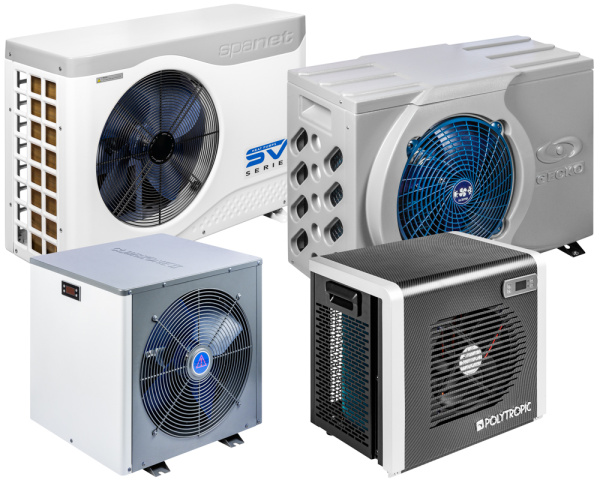How to choose the right heat pump for your spa
Thanks to its low operating cost, the heat pump ensures that you can significantly reduce your heating bill. But on what do you base your choice? Depending on your period of use, with what power adapted to the volume of your pool, connected to a dedicated app, with the highest performance coefficient..?
Given the multitude of choices, criteria, technologies used and prices, it is not always easy to find your way around. It is therefore better to ask the right questions before buying to have all the cards in hand to choose the heat pump you need.
A heat pump according to the desired heating power
If you are satisfied with the current heating power of your spa, look for a HP that is capable of returning roughly equivalent power (often 3 kW) during the time of year when you use your spa.
The heating power impacts the speed at which the water will heat up. You will not realise the power of your HP when the water is already at the desired temperature. The difference is especially noticeable after a water change, when the heat pump must raise fresh water to the right temperature.
If you use your pa's built-in heater to help raise the temperature after each water change, you can use a heat pump with lower heating power for temperature maintenance. It will be even more effective if you choose a variable speed heat pump (called "full inverter"), because this type of heat pump is more efficient (more heating power per kWh consumed) when it runs at low speed, just to maintain a stable temperature.
A heat pump according to your geographical area
The heat pump draws energy from the outside air, so it depends greatly on the temperature of your region: the colder it is outside, the more effort it must put into producing heat. If you live in a temperate region, you will need a less powerful heat pump than if you live in a cold and/or mountainous region.
Do not forget about humidity either! Cold and dry weather will have a lower yield than cold and humid weather or it is easier, at the same temperature, to recover calories in the humidity.
Finally, do you regularly use your spa all year round, or is it more for seasonal use, only during the least cold periods? It is necessary to provide a more powerful HP for use throughout the year than for more ad hoc use.
All our heat pump
According to your criteria and needs, Tubs Parts gives you all the information you need to choose the best heat pump for your spa. You need more information? Don't hesitate to contact us, we'll be happy to help!
|
Balboa Clim8zone |
Balboa Clim8zone II |
Gecko |
Gecko in.temp mini |
Polytropic Urban |
Polytropic Stepio |
SpaNet |
||
|
Air ≈ 26°C |
Heating power |
7,5 kW |
4,0 kW |
5,5 kW |
3,032 kW |
5,2 kW |
7,2 kW |
5,6 kW |
|
COP |
6,5 |
5,0 |
6,21 |
4,41 |
5,3 |
4,6 |
5,8 |
|
|
Air ≈ 15°C |
Heating power |
5,8 kW |
2,5 kW |
4,0 kW |
1,945 kW |
4,0 kW |
5,3 kW |
4,3 kW |
|
COP |
5,0 |
4,0 |
4,6 |
3,1 |
4,3 |
4,6 |
5,0 |
|
|
Power imput (max) |
1,1 kW |
0,8 kW |
0,9 kW |
0,93 kW |
1 kW |
1.4 kW |
1.1 kW |
|
|
Operating temperatures |
-20°C to 43°C |
-5°C to 43°C |
-5°C to 43°C |
0°C to 43°C |
0°C to 43°C |
-10°C to 43°C |
0°C to 40°C |
|
|
Noise level at 10m - dB(A) |
40-52 |
45 |
n. a. |
n. a. |
35 |
29 |
n. a. |
|
|
Noise level at 1m - dB(A) |
n. a. |
30 |
51 |
51,2 |
63 |
61 |
<49 |
|
|
Minimum water flow |
13,5 |
28 |
18,3 |
20 |
25 |
50 |
36,6 |
|
|
Réversible * |
✅ |
✅ |
✅ |
❌ |
❌ |
❌ |
✅ |
|
|
Inverter / Full inverter ** |
✅ |
✅ |
✅ |
❌ |
❌ |
✅ |
✅ |
|
|
Dimensions |
794 x 474 x 430 |
496 x 498 x 486 |
794 x 395 x 555 |
412 x 385 x 350 |
458 x 310 x 395 |
774 x 398 x 489 |
960 x 320 x 615 |
|
|
Managed from a smartphone |
❌ |
❌ |
✅ |
✅ |
❌ |
✅ |
✅ |
|
|
Managed from a spa keyboard |
✅ |
✅ |
✅ |
✅ |
❌ |
❌ |
✅ |
|
|
With integrated step system |
❌ |
❌ |
❌ |
❌ |
❌ |
❌ |
||
|
Connection diameter |
1,5" | |||||||
* A heat pump with reversible function means that you can heat or cool your spa water according to the season.
** The Inverter technology prevents on/off cycles and ensures continuous operation: the compressor power adjusts in real time to the outside temperature to maintain the set temperature in the spa. Once the required temperature has been reached, the compressor reduces speed without stopping, thus avoiding consumption peaks.
